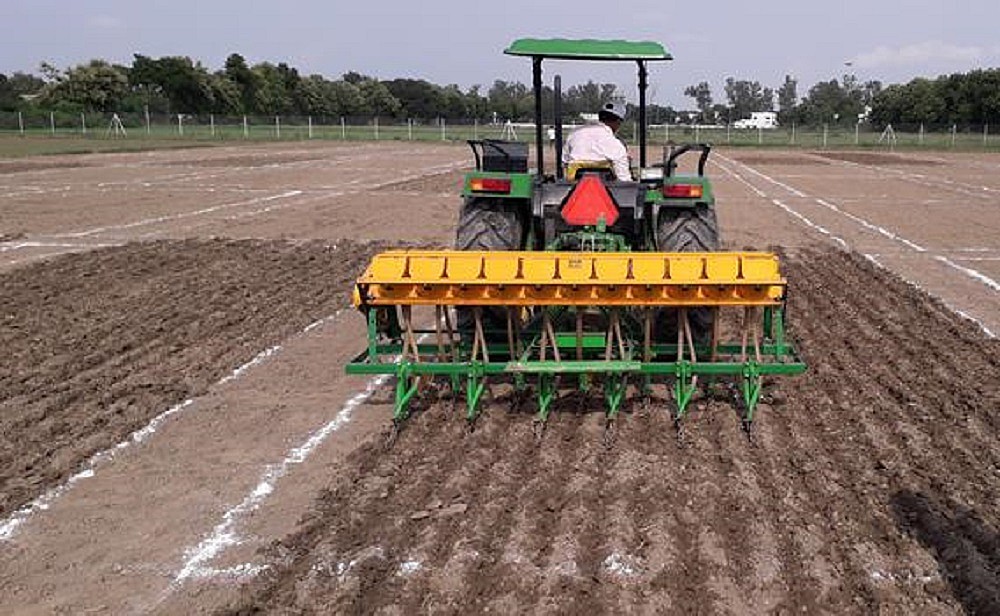Developing climate-smart rice production technologies offers a promising strategy to combat climate change, increase rice yields, achieve sustainable agriculture, and help ensure long-term food security. These climate-smart technologies play a crucial role in mitigating climate risks while simultaneously becoming economically viable and reducing environmental footprints.
 Mechanized DSR offers multiple benefits that enable early rice harvesting, timely sowing of seeds, and higher yields of succeeding crops such as wheat, chickpea, and mustard. (Photo: ISARC)
Mechanized DSR offers multiple benefits that enable early rice harvesting, timely sowing of seeds, and higher yields of succeeding crops such as wheat, chickpea, and mustard. (Photo: ISARC)
.
Rice, a staple cereal in the diets of more than half of the global population, including over 60% of India’s population relying on it as a primary food source. However, its production is confronting a multitude of obstacles. India ranks as the world’s second-leading producer of rice after China, contributing 24% to the global rice yield, but this sector faces a wide range of challenges that need to be addressed.
Inappropriate management practices, injudicious agricultural input use, and the impacts of climate change are negatively affecting natural resources, posing an imminent threat to global food security.
Severe climatic conditions, including recurrent droughts, floods, and high temperatures, are leading to crop failures that are adversely affecting the livelihoods of Indian farmers. The lack of knowledge and understanding on to these extreme climatic events further compounds their struggles. Moreover, the contribution of agriculture-related greenhouse gas emissions from the field burning of crop residues and unsustainable production practices further exacerbate these challenges.
It is crucial to prioritize a transition away from unsustainable agricultural practices towards climate-smart and sustainable approaches to effectively address the climate-related issues at hand.
The UN Food and Agricultural Organization defines climate-smart agriculture as a vision of how agricultural systems can be transformed and reoriented to support the development and ensure food security in a changing climate based on social, economic, and environmental factors, including agroecological zones.
When considering rice production systems, there is an opportunity to enhance profitability and sustainability by adopting climate-resilient and resource-efficient technologies. These include alternate wetting and drying technology, mechanized direct-seeded rice (DSR), laser land leveling, community-based staggered rice nursery enterprise, mechanically transplanted rice, site-specific nutrient management, integrated weed management, as well as crop residue management.
These climate-smart technologies play a crucial role in mitigating climate risks while simultaneously becoming economically viable and reducing environmental footprints.
For instance, the adoption of mechanized DSR offers multiple advantages, including 20-25%water savings, 40% labor reduction, lower production costs of approximately USD 120/ha, an increase in net profits of USD 100-125/ha, 20-44% a decrease in drudgery and global warming potential, and 7-15 days crop duration reduction.
These benefits enable early rice harvesting, timely sowing of seeds, and higher yields of succeeding crops such as wheat, chickpea, and mustard.
Developing climate-smart rice production technologies offers a promising strategy to combat climate change, increase rice yields, achieve sustainable agriculture, and help ensure long-term food security. This approach has the potential to double farmers’ income while achieving UN 20230 Sustainable Development Goals, particularly Zero Hunger and Climate Action.







Plz share information related to DSR(Directed seeded rice) cultivation
Please visit the link below for more information about direct-seeded rice:
https://tinyurl.com/4bbatyck
DSR is the need of hour because when we talk about the soil condition of rice wheat cropping system in northern plain as well as saving of human life while application of agrochemicals during transplanting the rice.